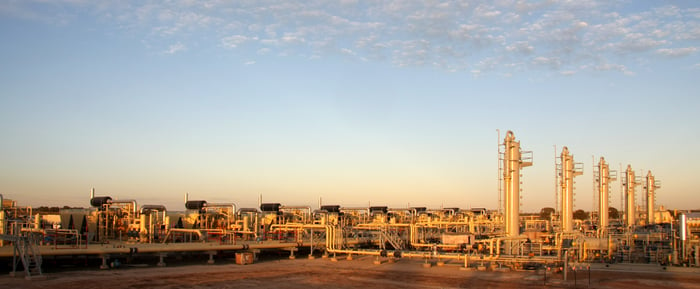Last month Enterprise Products Partners (EPD -0.50%) announced that it signed an agreement to acquire the midstream business and assets of bankrupt Azure Midstream Partners. That agreement came after the company won the bankruptcy auction proceedings by submitting the winning bid of $189 million. That price represented an unbelievable discount to what Azure paid for the assets a few years ago, enabling Enterprise to continue its disciplined approach to growth.
Picking up a bargain
Under the terms of the agreement, Enterprise Products Partners will acquire several assets. These include over 960 miles of natural gas gathering lines, three natural gas processing facilities with total capacity of 210 million cubic feet per day, and two 10,000 barrel-per-day NGL pipelines. These assets are in East Texas and North Louisiana and serve production from the Haynesville shale as well as other gas plays in the region. That location is worth noting because the assets will compliment Enterprise's existing system in the area, which includes East Texas NGL, Texas Intrastate natural gas pipeline, and its Haynesville gathering and Acadian natural gas pipeline system.

Image source: Getty Images.
Not only did Enterprise pick up a complimentary piece to its portfolio but it did so at a heavily discounted price. For example, last February Azure paid its parent company $162.5 million for the Legacy Gathering System, which consisted of 658 miles of pipeline in Texas and Louisiana. It followed that up a few months later with the $83 million acquisition of the EFG System, which consisted of 225 miles of gathering lines and a small processing plant. The company also picked up other assets along the way before succumbing to the weight of its debt. It was that debt induced bankruptcy that enabled Enterprise to buy these assets for less than full value.
Azure Midstream Partners initially sought to sell itself for $151.1 million after receiving a bid from M5 Midstream. However, that was a "stalking-horse" bid aimed at setting a floor so that creditors would recoup some value for the assets. That floor price allowed Enterprise to step in with its top-tier balance sheet and make the winning bid. However, even though it paid well above the floor price, the company still got a good deal because the assets are immediately accretive to Enterprise's distributable cash flow.

Image source: Getty Images.
$26 billion and counting
With the purchase of Azure's natural gas assets, Enterprise Products Partners has now made more than $26 billion of acquisitions since its IPO in 1998. However, the bulk of those purchases came during the recent oil market downturn after the company spent a combined $8.1 billion to acquire Oiltanking and EFS Midstream. While Oiltanking was the larger deal, the company's $2.15 billion acquisition of EFS Midstream from Pioneer Natural Resources (PXD 0.08%) and Reliance Industries was interesting given the situation surrounding the deal. That's because a driving factor was that it provided Pioneer with the cash it needed to continue drilling wells during the downturn, suggesting it might not have parted with the assets if it didn't need the capital. Meanwhile, Enterprise gained control of a slew of midstream assets that it locked up under long-term fixed-fee contracts that will provide the company with steady cash flow for years to come.
In addition to that, Enterprise also briefly explored a combination with Williams Companies (WMB 0.46%) last fall after its merger to Energy Transfer Equity (ET 0.22%) fell apart. That deal would have been the largest in Enterprise's history given that Williams Companies had agreed to a $37.7 billion combination with Energy Transfer Equity before a tax issue, and the worsening oil market downturn, derailed the deal. That said, Enterprise quickly abandoned its pursuit after market rumors drove Williams' stock price up well past Enterprise's liking. The reason the company walked away is due to a pledge to remain financially disciplined as it pursues future growth opportunities.
Enterprise's other growth driver
One place where it has found plenty of compelling opportunities is investing in organic growth projects. The company has already spent $36 billion on expansion projects since its IPO, and it has another $8.4 billion of projects in the pipeline. That's up from $5.3 billion at the start of the year after recently adding a couple of new projects to the backlog. Further, it has several more in development, suggesting that the pipeline could continue growing. This backlog provides the company with clear visibility as to where future cash flow growth will come from, likely enabling it to keep the distribution growth streak alive.
Investor takeaway
Enterprise Products Partners scored an unbelievable deal when it picked up several gas-related assets at a bankruptcy auction earlier this year. Those assets are not only an excellent strategic fit but are immediately accretive to cash flow. It's just another example of the company's disciplined approach to build or buy assets that bolster the bottom line. It's a strategy that should enable Enterprise to continue paying investors a growing income stream for years to come.





